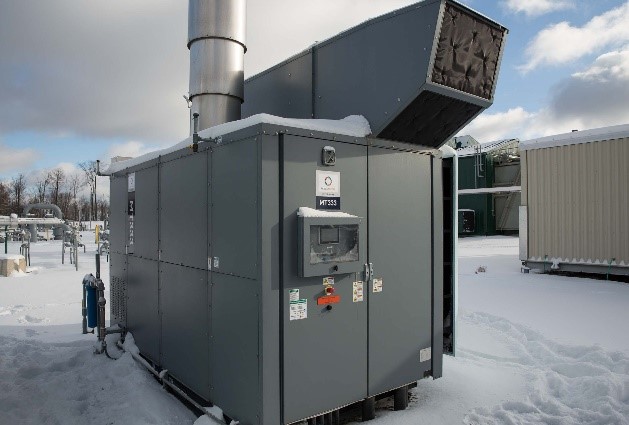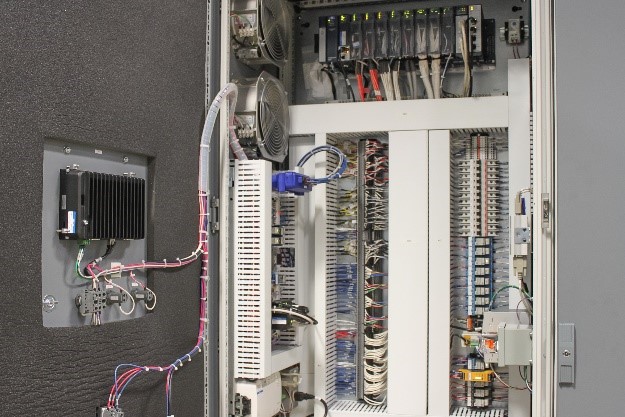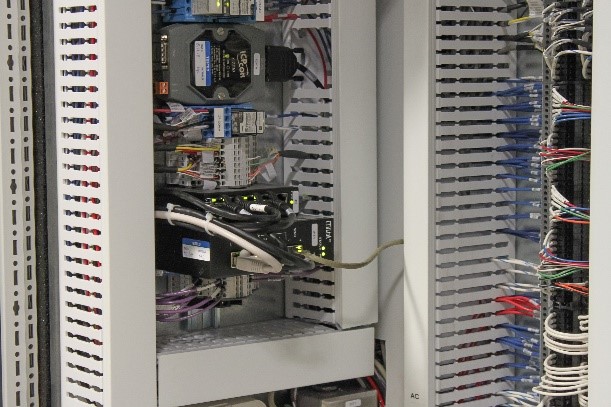Contemporary Controls' EIPR Skorpion IP routers were used by FlexEnergy to simplify the machine installation and network configuration of their GT333 Gas Turbine System. The project required a method that would simplify the Ethernet network within the control system allowing technicians to have dependable external access to the devices without IP address conflicts.

FlexEnergy, headquartered in Portsmouth, New Hampshire, engineers and builds robust small gas turbine products. The GT333 consists of a 480V AC high-voltage panel where the generator is located and a 120V AC and 24V DC low-voltage panel for the controls.
"During development of the GT333, we were looking for a method to simplify the Ethernet network within our control system. We had two goals in mind, one goal was to create a 'cookie-cutter' setup of all the devices within the machine to make the configuration of all machines the same, thus simplifying configuration management and service training," said Adam Mitchneck, Controls Engineer at FlexEnergy. "The other goal was to have only one IP address for external access to all devices within the machine, thus simplifying network configuration on customer sites. While searching for a method to achieve our goals we happened upon Contemporary Controls and their Skorpion IP routers."
The Skorpion IP router simplifies device IP intergration. Each machine or subsystem, consisting of multiple IP devices, connects to the LAN side of the router while keeping their same IP settings for the devices and the application, lowering installation cost and eliminating trouble shooting. The IP address for the WAN port on the IP router is the only setting that requires modification to join the factory network, allowing rapid integration and the ability for multiple machines to reuse the same configuration on the LAN side.

The GT333 control panel consists of a PLC, an HMI, an embedded PC, and an inverter that form an internal network that is connected to the LAN side of the IP router with a built-in 4-port switch. For sites requiring additional IP equipment on the internal network, a Contemporary Controls 5-port EISK5-100T Ethernet switch was used for expansion. The available Ethernet ports can also be used by the customer to add additional devices to the network if required.
Using the Port Forwarding feature of the IP router, the different IP ports from the external WAN IP address were mapped to different internal LAN devices in the control panel. This setup was then easily uploaded to multiple routers for use in different turbines allowing for the same configuration to be used across all the devices. This helped speed up the testing of the turbine while being built at the factory and the installation at the site by just requiring the WAN IP address to be configured. No other IP settings for the devices or the applications needed to be modified at the install site.

The setup allowed FlexEnergy to have direct access to the PLC through the router, allowing for the programming or monitoring of the PLC. The HMI could also be accessed through the router as well as the inverter. The inverter could be enabled or disabled along with the ability to monitor the battery status. The embedded PC ran some proprietary applications but again, it could be easily accessed from the WAN side by a remote desktop application. All the tools could be run locally on the embedded PC without adding extra traffic to the customer's network.
The Skorpion series of IP routers eases the integration of new machines into the existing network. The EIPR routers have a 10/100Mbps Ethernet WAN port and a built-in 4-port LAN switch. The EIGR series of IP and VPN routers add Gigabit ports for faster speeds and higher data throughput. The EIGR-C series of cellular routers offers built-in cellular modem for easy connectivity to cellular networks. A built-in firewall prevents direct unauthorized access to the LAN side devices from the WAN side. But the routers provide features, such as Port Forwarding, Port Range Forwarding and NAT, that allow for WAN to LAN access. The WAN port can be configured for a static IP address or can be assigned a DHCP address via the built-in DHCP client for greater flexibility in integrating quickly to the customer's network. The IP router also keeps the multicast and broadcast traffic separated to the LAN or WAN network, keeping the IP devices running smoothly without having to deal with unnecessary traffic filtering. The scheme can be easily applied for integrating any IP device network irrespective of the IP traffic or the industry type. The routers are DIN-Rail mounted, have a robust metal enclosure, are UL approved, and operate on 24V AC/DC which makes for an easy addition in a control panel.
"Initially, we were using the EIPR-E router to simplify our machine's setup," said Mr. Mitchneck. "With fixed IP address for every device, our service technicians can quickly locate the device they wish to communicate with regardless of the customer's site. We have since upgraded to the new EIGR-E gigabit Ethernet router for its higher throughput and support of 1000T communication. Transition from the EIPR-E to the EIGR-E was smooth and painless as the two routers have a similar setup and footprint. We have been very pleased with the performance and reliability of the EIGR-E router. It has enabled our customers to collect more data at faster rates for applications requiring higher throughput."
VPN models of the Skorpion routers are also available that provide secure remote access.



